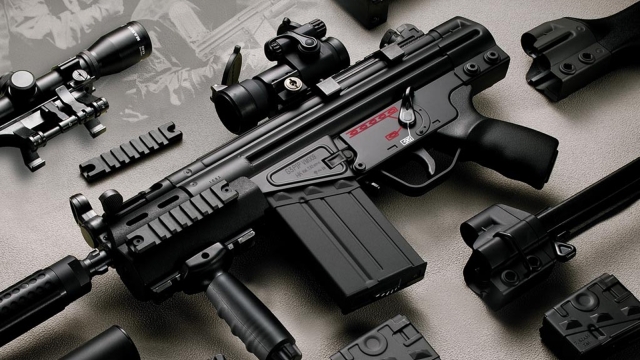Firearms have been prominent in human history for centuries, evolving in both design and purpose. These powerful instruments, often misunderstood, have shaped warfare, provided protection, and facilitated hunting throughout different eras. The mastery of firearms requires not only technical proficiency but also an understanding of their inner workings. By delving into the world of firearms, we can unearth the secrets behind their operation and appreciate the craftsmanship that goes into each piece.
At the heart of any firearm lies its ammunition. Just as a warrior needs their weapon, firearms rely on their ammunition to unleash their potential. Understanding the intricate relationship between firearms and ammunition is crucial for comprehending the true power they possess. Bullets, cartridges, and powder blends may seem inconspicuous, but they hold the key to translating force into motion. From the shape and composition of projectiles to the precise measurements of powder loads, the science behind ammunition ensures that every shot is intentional and effective. Without a deep appreciation for this foundation, the full potential of firearms will forever remain shrouded in mystery.
Understanding Ammunition
In order to fully understand firearms, it is essential to have a clear grasp of the role of ammunition. Ammunition, also referred to as rounds or bullets, is the crucial element that propels a firearm’s projectile towards its intended target.
Ammunition consists of multiple components that work together to create the necessary force and energy for the firearm to function. The main components include the cartridge case, the primer, the propellant, and the bullet.
The cartridge case, typically made of brass, serves as the container for all the other components. It houses the primer, propellant, and bullet in a tightly sealed unit. This ensures that the explosive energy generated upon firing is properly contained and directed.
The primer is a small, sensitive explosive compound located at the base of the cartridge case. When struck by the firing pin, the primer ignites, creating a spark. This spark then ignites the propellant, which is a specially formulated chemical mixture. As the propellant burns, it rapidly produces large volumes of gas, creating pressure within the cartridge case.
The pressure generated by the burning propellant forces the bullet, which is typically a metal projectile, out of the cartridge case and through the barrel of the firearm. The bullet then travels towards the target, propelled by the expanding gases and the barrel’s rifling, which imparts spin to stabilize its flight.
Understanding the components and functioning of ammunition is crucial for anyone interested in firearms. By familiarizing oneself with ammunition, it becomes possible to appreciate the intricate mechanisms that allow firearms to function as powerful tools for various purposes.
Different Types of Firearms
-
Pistols: Pistols are one of the most common types of firearms. They are designed to be held with one hand and offer great portability and concealability. Pistols are semi-automatic firearms, meaning they automatically load the next round into the chamber after each shot. They typically utilize magazines to hold multiple rounds of ammunition, making them suitable for self-defense and personal use.
-
Rifles: Rifles are long-barreled firearms that are shouldered and fired from the shoulder. They are known for their accuracy and range, which make them suitable for varmint hunting, sport shooting, and military use. Rifles can be single-shot, bolt-action, semi-automatic, or fully automatic, depending on their design and purpose. They often come with detachable magazines that hold varying capacities of ammunition.
-
Shotguns: Shotguns are firearms that fire a cluster of small round pellets, known as shot, or a single large projectile called a slug. They are popular for hunting, sport shooting, and home defense due to their wide range of ammunition options. Shotguns can have different actions, including pump-action, semi-automatic, and break-action, which allow for quick reloading and flexibility in firing various types of ammunition.
Remember, firearms are powerful tools that require responsible ownership and usage. Proper training and adherence to safety guidelines are crucial to ensure the appropriate and legal use of these weapons.
The Impact of Firearms on Society
Firearms have had a profound impact on society throughout history. From their invention to their widespread use today, these weapons have shaped the course of nations and individuals alike.
One significant effect of firearms is their role in warfare. They have revolutionized the way battles are fought, offering increased firepower and range. The introduction of firearms drastically changed military tactics, as armies had to adapt to the new threat posed by these powerful weapons. From muskets and rifles to machine guns and artillery, firearms have played a pivotal role in shaping the outcomes of conflicts worldwide.
Beyond the battlefield, firearms have also influenced the social fabric of communities. They have been used for self-defense, providing individuals with the means to protect themselves and their loved ones. This aspect of firearms ownership has been a source of controversy, with debates surrounding the right to bear arms and the responsibility of gun owners.
Moreover, firearms have contributed to the growth of recreational activities such as hunting and sport shooting. These activities have become popular pastimes, fostering communities and traditions centered around firearms as tools for recreation and skill development.
In conclusion, the impact of firearms on society is undeniable. Their influence on warfare, self-defense, and recreational pursuits has shaped our history and continues to shape our present. Understanding the role and significance of firearms is key to comprehending the complexities of our world today.

